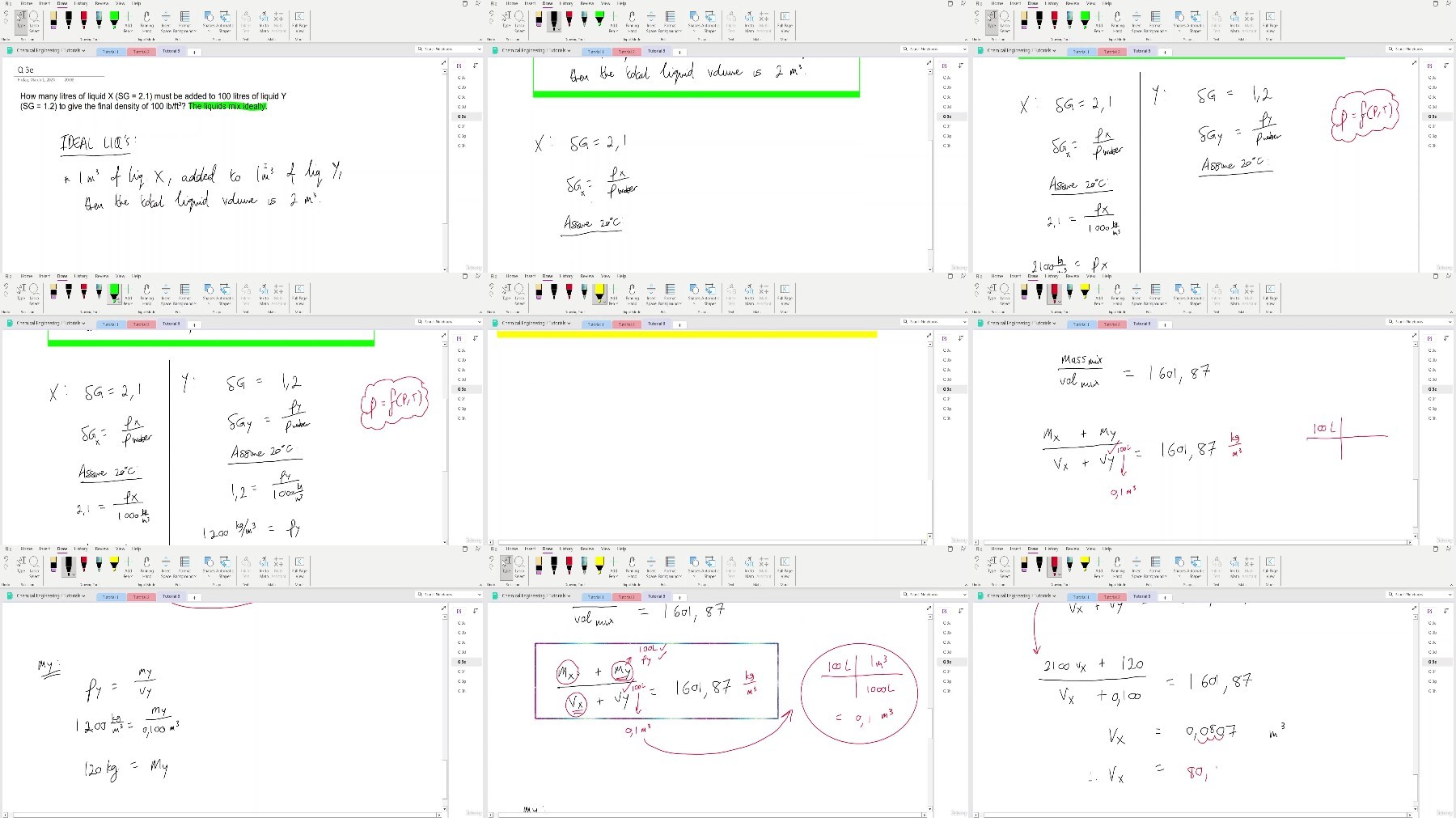
Chemical Engineering: Basic Concepts And Calculations
Published 3/2024
MP4 | Video: h264, 1920x1080 | Audio: AAC, 44.1 KHz
Language: English
| Size: 2.64 GB[/align]
| Duration: 9h 6m
An introduction to Chemical Engineering. Learn from an Engineer with experience in Oil, Gas and Chemical processing.
[b]What you'll learn[/b]
Make use of the Ladder Method for basic and complex conversions
Convert between Metric, Imperial and CGS unit systems
Perform dimensional analysis for equations
Convert between mass, molar and volumetric flowrates
Interpret density and bulk density
Interpret specific gravity and specific volume
Understand ideal liquid mixing
Understand mole ratios and empirical formulae
Calculate mass and mole fractions, and mass and mole percentages
Know when to use mass fractions and mole fractions in calculations
Calculate density for a liquid mixture
Calculate density for a pure gas, and a gas mixture
Calculate average molar mass of a gas mixture
Calculate linear velocity in a pipeline
Understand NTP (Normal Temperature and Pressure) and STP (Standard Temperature and Pressure)
Convert gas volume between NTP and STP
Know under which conditions the Ideal Gas Law is valid
Use the Ideal Gas Law to calculate gas properties
Understand the difference between Molarity and Molality
Calculate the Molarity and Molality of a susbstance
Understand Normality and apply it in calculations
Stoichiometrically react acids and bases
Understand ratios and apply them to chemical compositions
[b]Requirements[/b]
This course requires a good understanding of High School (Grade 12) Mathematics, Physical Science and Chemistry.
No chemical engineering experience is required.
[b]Description[/b]
Hi, I'm Kaamil the Chemical Engineer.I currently work as a Process Engineer in a multinational petrochemicals company. It is one of the largest companies by market cap on the Johannesburg Stock Exchange. Many of the concepts you will read about in your textbooks, I have seen with my own two eyes. So, I would like to share these experiences with you. I hope that my stories will make your first year of Engineering a bit less abstract.Chemical Engineers are lauded worldwide for their problem-solving abilities, and that is exactly what I want you to learn from this course. Once you have these skills, you can apply them to Investing, Engineering, Business and more.We will cover a range of examples, all of which require an innovative approach and a sharp mind. Sections covered include: unit conversions, dimensional analysis, mass and mole fractions, densities and bulk densities, specific volume and specific gravity, the ideal gas law, molar mass of a gas mixture, flowrates in pipelines, mixing operations, and more.You can use the examples to teach yourself, and then use the test questions to evaluate your problem-solving skills.This should set you on your way to becoming a great Engineer!
Overview
Section 1: Course Introduction
Lecture 1 Thank you from Kaamil-Inaam!
Section 2: Tutorial 1: Conversions and dimensional analysis
Lecture 2 Tutorial 1 All Questions
Lecture 3 Tutorial 1a: Converting flowrates
Lecture 4 Tutorial 1b: Converting flowrates
Lecture 5 Tutorial 1c: Converting density
Lecture 6 Tutorial 1d: Converting density
Lecture 7 Tutorial 1e: Converting energy (lbf, poundal, J)
Lecture 8 Tutorial 1f: Converting kinetic energy (lbf. poundal, J)
Lecture 9 Tutorial 1h: Converting viscosity (using base units)
Lecture 10 Tutorial 1i: Converting viscosity (using base units)
Lecture 11 Tutorial 1j: Converting power
Lecture 12 Tutorial 1k: Converting flowrates
Lecture 13 Tutorial 1l: Converting density
Lecture 14 Tutorial 1m: Converting power (using hp and BTU)
Lecture 15 Tutorial 1n: Dimensional analysis
Section 3: Tutorial 2: Applied unit conversions and dimensional analysis
Lecture 16 Tutorial 2 All Questions
Lecture 17 Tutorial 2a: Volume calculation
Lecture 18 Tutorial 2b: Kinetic energy calculation
Lecture 19 Tutorial 2c: Potential energy calculation
Lecture 20 Tutorial 2d: Reynolds number calculation
Lecture 21 Tutorial 2e: Speed, distance, time calculation
Section 4: Tutorial 3: Bulk density, Liquid mixing, Mass and Mole fractions
Lecture 22 Tutorial 3 All Questions
Lecture 23 Tutorial 3a: Using density data
Lecture 24 Tutorial 3b: Calculating specific gravity
Lecture 25 Tutorial 3c: Calculating density and specific volume
Lecture 26 Tutorial 3d: Calculating liquid transfer time
Lecture 27 Tutorial 3e: Ideal liquid mixing
Lecture 28 Tutorial 3f: Bulk density
Lecture 29 Tutorial 3g: Calculating bulk density
Lecture 30 Tutorial 3h (part a): Mole fractions; Choosing a basis
Lecture 31 Tutorial 3h (part b): Empirical formula; Choosing a basis
Lecture 32 Tutorial 3h (part c): Mass fractions and powder mixing
Lecture 33 Tutorial 3h (part d): Mole fractions and gas mixtures
Section 5: Tutorial 4: Ideal gases (mixtures, STP, NTP)
Lecture 34 Tutorial 4 All Questions
Lecture 35 Tutorial 4a: Gas mixtures (density, molar mass, mole fractions)
Lecture 36 Tutorial 4b: Normal Temperature and Pressure
Lecture 37 Tutorial 4c: Density of an ideal gas
Lecture 38 Tutorial 4d: Specific gravity of a gas
Lecture 39 Tutorial 4e: Standard Temperature and Pressure
Lecture 40 Tutorial 4f: Specific gravity of an ideal gas
Lecture 41 Tutorial 4g: Density of an ideal gas
Lecture 42 Tutorial 4h: Specific volume of an ideal gas
Lecture 43 Tutorial 4i: Temperature of an ideal gas
Section 6: Tutorial 5: Mixture concentrations
Lecture 44 Tutorial 5 All Questions
Lecture 45 Tutorial 5a: Mole fractions
Lecture 46 Tutorial 5b (part i): Mass fractions
Lecture 47 Tutorial 5b (part ii): Density of mixture
Lecture 48 Tutorial 5b (part iii): Molarity
Lecture 49 Tutorial 5c: Mass and Mole fractions of a mixture
Lecture 50 Tutorial 5d (part a): Mole fractions
Lecture 51 Tutorial 5d (part b): Mass fractions
Lecture 52 Tutorial 5d (part c): Molarity
Lecture 53 Tutorial 5d (part d): Density
Lecture 54 Tutorial 5d (part e): Molarity
Lecture 55 Tutorial 5d (part f): Normality
Lecture 56 Tutorial 5e: Molar mass of an ideal gas mixture
Lecture 57 Tutorial 5f: Mass fractions of a liquid mixture
Lecture 58 Tutorial 5g (part a): Density of a liquid mixture
Lecture 59 Tutorial 5g (part b): Mass fraction of a liquid mixture
Lecture 60 Tutorial 5g (part c): Mass ratio of a liquid mixture
Lecture 61 Tutorial 5g (part d): Molarity of a liquid mixture
Lecture 62 Tutorial 5g (part e): Molality of a liquid mixture
Lecture 63 Tutorial 5h (part a,b,c): Normality
Lecture 64 Tutorial 5h (part d): Normality cont'd
First year Chemical Engineering Undergraduate Students,CIR 113 students at the University of Pretoria

https://rapidgator.net/file/db9fdcdac66c60c324241e01117ea0fa/ https://rapidgator.net/file/650634f8d1a3003a6dbf47c3c78af52b/

https://ddownload.com/pas92t4rog17 https://ddownload.com/453wz14a4in3
Chemical Engineering Basic Concepts and Calculations

